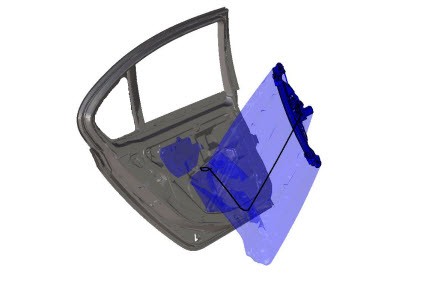Pro.PathFreezer
Client Requirements
In an automobile a number of dynamic processes, such as, for example, the vibration of an engine when driving on a rough or uneven stretch of road, must be taken into account. For such extreme situations it therefore makes sense to check already in the development phase whether the stipulated safety clearances of the engine to the package space are indeed adhered to. A manual inspection of all the positions of movement in the virtual vehicle is extremely time-consuming and furthermore is clearly also prone to error. This situation can be resolved by the generation of dynamic envelopes. These dynamic envelopes serve on the one hand as package space place-holders for design modifications in the surrounding environment, and on the other hand it will be guaranteed that the required space will be reserved or rather the intrusion of another assembly will be automatically detected. An example for the employment of this solution in practice is the generation of a dynamic envelope for the disassembly path of a window winder.
Teraport Solution
Pro.PathFreezer converts dynamic processes into static swept volume geometry. The model and the corresponding path of movement are entered via the workflow user interface DMU.Connect or within a workbench of Teraport’s 3D-Viewer DMU.View. The accuracy of the envelope depends on the one hand on the measurement intervals in the path of movement. On the other hand, the desired accuracy can also be specified prior to the calculation by the selection of the degree of granularity.
Benefit for the Client
Complex movements are converted into static geometry and in so doing, the envelope’s data volume is significantly reduced in comparison to the original model (a reduction of up to 90%). On the basis of this static model it is now possible to easily check, if a nearby assembly is injuring its motion area or not. This transparency ensures that errors can be counteracted at an early stage, which will clearly result in a reduction of costs and working time. The efficiency of this process solution is particularly apparent in the case of complex models and complex movements. The stable calculation process ensures that only the actual outer surfaces of the movements are incorporated. The algorithm furthermore guaranties that the moving model at no point protrudes from the generated envelope, thus ensuring that no possible collisions or failure to adhere to specified clearances in respect of the surrounding environment can be overlooked.

